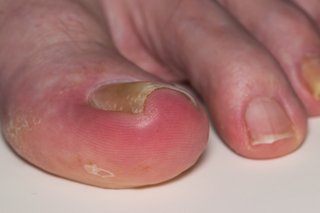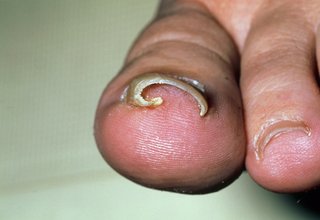An ingrown toenail is a common problem where the nail grows into the toe.
Check if you have an ingrown toenail
You usually get an ingrown toenail on your big toe. But you can get them on any toe. Your toe can also get infected.
See what an ingrown toenail looks like


Urgent advice: See your GP or podiatrist if:
- you have diabetes - foot problems can be more serious if you have diabetes
- your toe is painful and swollen with pus coming out of it
- you have a high temperature
Managing an ingrown toenail at home
An ingrown toenail can be painful, but there are things you can do to ease the pain.
Do
-
soak your foot in warm, salty water to help soften the skin around your toe and reduce the chances of infection
-
keep your foot dry
-
wear wide, comfortable shoes or sandals
-
take paracetamol or ibuprofen to ease the pain
Don't
-
do not cut your toenail - leave it to grow out
-
do not pick at your toe or toenail
-
do not wear tight, pointy shoes
Medical treatment for an ingrown toenail
If treating your ingrown toenail at home is not helping, see your GP.
Your GP can give you antibiotics if your toenail is infected. They may refer you to a podiatrist.
Treatment from a podiatrist
You may be eligible for HSE podiatry services. Speak to your GP or public health nurse. You can also pay to see a podiatrist privately.
A podiatrist may offer treatments, such as:
- cutting away part of the nail
- removing the whole nail
You'll have an injection of local anaesthetic to numb your toe. After this treatment, you will need to rest your foot and keep it raised for 1 to 2 days.
Preventing ingrown toenails
To help stop ingrown toenails:
- do not cut your toenails too short
- cut straight across your nail
- do not wear shoes that are too tight or do not fit properly
- keep your feet clean and dry them fully
